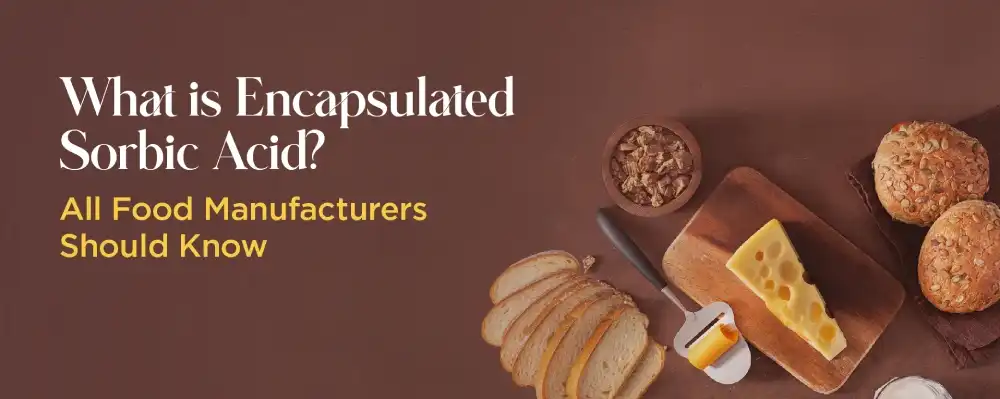Most Popular

In today’s quick, high-speed food processing era, shelf life with no loss of flavour, texture, and quality is more necessary than ever. Among numerous food preservatives applied universally, sorbic acid ranks high among the favourites for its ability to prevent mould, yeast, and some bacteria. However, pure or regular sorbic acid has some limitations that food companies are increasingly circumventing with encapsulation technology.
We’re discussing here what sorbic acid encapsulated is, what it can do that the regular version can’t, and how it’s also gaining popularity as a first-choice ingredient for baked food, dairy food, and other moisture-sensitive food uses.
Sorbic acid is a naturally occurring compound that previously existed in rowan berries. It’s industrially utilized as a food additive (E200) due to its antimicrobial property, primarily against fungi and moulds.
It’s most likely to be found in:
Raw sorbic acid is effective but not without problems when directly added into food matrices, particularly heat, fermentation, or pH-sensitive food recipes.
Encapsulated sorbic acid is basically sorbic acid encased in a protective coat, usually a lipid or starch-based material, that determines how quickly the active ingredient will be released during production.
Imagine it like a time-release capsule. The encapsulation prevents the sorbic acid from coming into contact with other ingredients too early in the mixing, fermentation, or baking process. When certain conditions, such as temperature or humidity, are met, the coating breaks away and releases the preservative at the exact right time when it is needed.
| Feature | Plain Sorbic Acid | Encapsulated Sorbic Acid |
| Release Timing | Immediate | Delayed/controlled |
| Interference with Yeast | High | Low to negligible |
| Stability in Processing | Moderate | High |
| Taste Impact | Can leave an acidic taste | No off-flavours |
| Ideal Use Case | Direct addition in ready-to-eat foods | Fermented/baked products, doughs |
Food manufacturers too often are faced with the challenge of how to add preservatives without compromising the food’s sensory or functional quality. That is where encapsulated sorbic acid comes into play with true benefits:
1. Preservation Without Compromising Fermentation
In products with yeast, such as bread, unchecked sorbic acid disrupts fermentation, ceasing yeast function and causing inadequate rise or a dense texture. Encapsulation retards the activity of the preservative following fermentation.
2.Targeted Release for Optimum Effectiveness
Where multiple-stage processing is required (e.g., baking and then cooling), time is an issue. Encapsulated sorbic acid prevents the preservative from taking effect only where conditions are optimal, most often when the product is cooled and microbial hazard is higher.
3.Enhanced Taste & Mouthfeel
As sorbic acid is an acid, direct use will generally result in a perceived aftertaste. Encapsulation prevents the use of acid during the initial phases of production, ensuring off-flavours are kept to a minimum.
4.Minimized Ingredient Interaction
Certain ingredients in food, such as proteins or emulsifiers, can interact with sorbic acid by binding to it and preventing it from working. The encapsulation barrier prevents that initial contact from happening, delivering the complete antimicrobial effectiveness.
5.Enhanced Shelf Life and Clean Label
Most encapsulated ingredients allow reduced usage levels due to their focused action, which makes them candidates for clean-label goals to be achieved through the use of “less” to deliver “more.”
Food researchers and R&D experts are increasingly making use of encapsulated preservatives to improve process control and shelf life. It is used intensely in the following applications:
Encapsulated sorbic acid is safe (GRAS) and accepted by key regulatory organizations, including:
As with all additives, labelling acceptability is of the highest priority, especially if the encapsulating agent itself is being considered as an additive.
Irrespective of whether you operate in the fermented food, bakery, or high-moisture foods sector, the move to encapsulated sorbic acid can help you increase shelf life, reduce spoilage cost, and enhance product quality without compromising on the clean label and consumer confidence.
At Koel Colours, we believe in revolutionizing the food technologist and manufacturer’s needs. Our encapsulated ingredients are designed to deliver you ultimate process flexibility, improved shelf-life management, and improved product integrity.
To complement your preservation strategy? Let us discuss tailored encapsulated solutions.